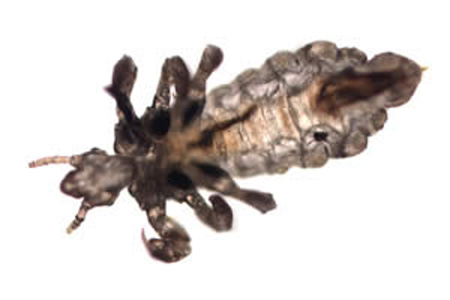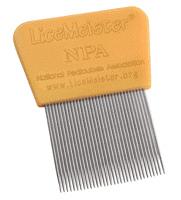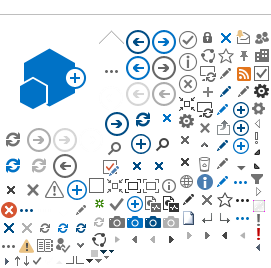Head Lice
(Pediculus humanus cap itis De Geer)

What are head lice?
Head lice are bloodsucking insects that live exclusively on humans. They are usually found on the scalp, behind the ears, near the neckline at the back of the neck, and eyelashes. These parasitic insects need human blood and body warmth to survive and will die if separated from their host for only a couple of days. Head lice cannot survive for very long in rugs, carpet, or within upholstery on school buses. To feed, the louse bites through the skin and injects saliva which prevents blood from clotting; it then sucks blood into its digestive tract. Their feeding can cause intense itching and scratching of the scalp.
How can I identify head lice?
Head lice are very small insects that hatch from eggs. Head lice eggs are called nits. They are about the size of a thread knot, oval in shape, yellow to white in color, and are attached singly to the hair shafts close to the scalp. Nits hatch in 7-10 days into immatures or nymphs. The nymphs begin feeding on blood and will develop over the next 7-12 days into adults. Nymphs are similar in appearance but smaller than adults. They have 6 legs and are tan to grayish-white in color. Adult lice are about the size of a sesame seed, approximately 1/8 inch in length. Adult lice also need to feed on blood to live. Adult female lice can lay 6-7 nits per day and may lay a total of 50 to 100 eggs during their lifetime of up to 40 days. |

Actual size of lice compared to a penny. (CDC photo)
|
Who is at greatest risk for getting head lice?
Anyone who comes in close contact, especially head-to-head contact, with someone who already has head lice is at greatest risk. It is incorrect to associate head lice with poverty, poor personal hygiene, race, or hair type, color, or length. Head lice can be found on all people but most often they infest preschool and elementary school children, ages 3-11, and their families.
What are the ways you can get head lice?
Head lice are not spread to humans from pets or other animals. Head lice cannot fly and do not jump. However, they can crawl quickly, using their hook-like claws to grab onto hair or fabric. Head lice and nits are easily transmitted from person to person on shared hats, coats, scarves, combs, brushes, towels, bedding, upholstered seats in public places, and by physical contact between humans. Adult head lice cannot survive off the human host for more than 2 days. Nits on hair shafts can survive a few days longer.
How can I tell if I have a problem with head lice?
There are many things other than lice, that may cause itching and irritation, including “winter itch" from dry skin. Head lice should be suspected when there is intense itching and scratching of the scalp and the back of the neck or when there is a known infestation in the community. Close examination of the scalp will reveal nits firmly attached to hair shafts, especially at the nape of the neck and above the ears. Nits are usually found down near the roots of the hair. Although dandruff, dirt, oil, or hairspray may resemble nits, they can be removed easily from hair. Nits cannot be removed easily by pulling or washing. Close inspection may also reveal active lice and many itchy, red marks resulting from irritation caused by lice saliva/bite marks.
How do I treat a head lice infestation and prevent their return?
If you or a family member has head lice, contact your health care provider or local Preventive Medicine Service for advice about treatment. Notify your child's school and daycare facility if your child has head lice. Immediately inspect all family members and friends in contact with the infested individual. Controlling head lice infestations, and preventing their return involves 4 key steps:
-
Treat the Infested Person with a Pediculicide (Lice-Killing Medication). Only those showing evidence of lice and greater than 2 years of age should be treated. All household members and other close contacts should be checked; those persons with evidence of an active infestation should be treated. Treat the infested person with an over-the-counter or prescription medication. Use only those products that are approved by physicians and labeled for use in head lice control. Follow label directions exactly. Failure to do so can lessen control and may negatively affect the health and safety of the infested person as well as the caregiver. Treat all infested individuals at the same time. If over-the-counter medications do not appear to be effective, consult with your health care provider before using alternative products.
-
Use a Fine-Tooth Louse Comb to Remove Lice and Nits from Hair Shafts.
Nit removal is critical to eradication since pediculicides usually kill only 50-70% of the nits. Wet combing with any type of hair oil or conditioner is more effective than dry combing. Since most nits are attached at the base of the hair around the roots, concentrate on getting as close to the scalp as possible. Slowly pull the comb all the way through to the end of the hair strands. Repeat this procedure every 2-3 days until all lice and nits are gone.
|

|
-
Treat the Household and All Personal Articles. All personal items that have been in contact with an infested person's head should be deloused. Normal laundering, using the hot water cycle and drying using high heat for 20 minutes, or dry cleaning, will kill lice and nits on clothing, bed linens, and towels. Lice and nits can also be killed on non-washable items such as stuffed animals or other delicate items by placing them in sealed plastic bags for 2 weeks. Combs and brushes should be soaked for 10 minutes in a pan of very hot water. Vacuum mattresses, car seats, upholstered furniture, and carpeting, then discard the vacuum bag.
-
Reduce the Chance of Reinfestation. Regularly inspect children and other family members for head lice. Instruct children not to share hats, scarves, coats, sports uniforms, hair ribbons, combs, brushes, or towels with their classmates. Provide separate storage areas for each individual's clothing and other personal items, and put clothing on hangers or hooks to minimize the risk of contracting head lice. If possible, avoid head-to-head contact during play at school or at home. Do not lie on beds, couches, pillows, carpets, or stuffed animals that have recently been in contact with a lice-infested person. Never administer pediculicides as a preventive treatment.
What about home remedies?
Home remedies are not recommended. Most have not been tested thoroughly or simply do not work. Bleaches, dyes or other harsh detergents used in laundering clothes will not prevent or eradicate head lice. Their use can cause serious skin reactions. Hair gels, olive oils, mayonnaise, petroleum jelly or other household products have not been proven effective in suffocating lice.
Should I use pesticides to treat the household for head lice?
Since head lice and nits cannot survive for extended times off of human hosts, spraying, dusting or fumigating clothes, the interior of homes and vehicles with insecticides are generally not required nor recommended for control or prevention of head lice. Contact the Installation Pest Control Office and/or your local Preventive Medicine Service for additional guidance.
For more information:
